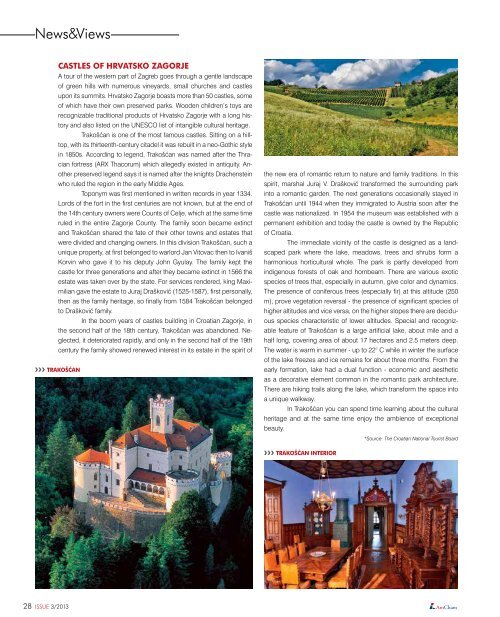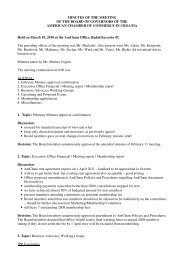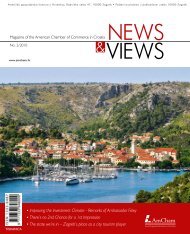No. 3 / 2013 - AmCham
No. 3 / 2013 - AmCham
No. 3 / 2013 - AmCham
- No tags were found...
Create successful ePaper yourself
Turn your PDF publications into a flip-book with our unique Google optimized e-Paper software.
News&ViewsCastles of Hrvatsko ZagorjeA tour of the western part of Zagreb goes through a gentle landscapeof green hills with numerous vineyards, small churches and castlesupon its summits. Hrvatsko Zagorje boasts more than 50 castles, someof which have their own preserved parks. Wooden children’s toys arerecognizable traditional products of Hrvatsko Zagorje with a long historyand also listed on the UNESCO list of intangible cultural heritage.Trakošćan is one of the most famous castles. Sitting on a hilltop,with its thirteenth-century citadel it was rebuilt in a neo-Gothic stylein 1850s. According to legend, Trakošćan was named after the Thracianfortress (ARX Thacorum) which allegedly existed in antiquity. Anotherpreserved legend says it is named after the knights Drachensteinwho ruled the region in the early Middle Ages.Toponym was first mentioned in written records in year 1334.Lords of the fort in the first centuries are not known, but at the end ofthe 14th century owners were Counts of Celje, which at the same timeruled in the entire Zagorje County. The family soon became extinctand Trakošćan shared the fate of their other towns and estates thatwere divided and changing owners. In this division Trakošćan, such aunique property, at first belonged to warlord Jan Vitovac then to IvanišKorvin who gave it to his deputy John Gyulay. The family kept thecastle for three generations and after they became extinct in 1566 theestate was taken over by the state. For services rendered, king Maximiliangave the estate to Juraj Drašković (1525-1587), first personally,then as the family heritage, so finally from 1584 Trakošćan belongedto Drašković family.In the boom years of castles building in Croatian Zagorje, inthe second half of the 18th century, Trakošćan was abandoned. Neglected,it deteriorated rapidly, and only in the second half of the 19thcentury the family showed renewed interest in its estate in the spirit of››› Trakošćanthe new era of romantic return to nature and family traditions. In thisspirit, marshal Juraj V. Drašković transformed the surrounding parkinto a romantic garden. The next generations occasionally stayed inTrakošćan until 1944 when they immigrated to Austria soon after thecastle was nationalized. In 1954 the museum was established with apermanent exhibition and today the castle is owned by the Republicof Croatia.The immediate vicinity of the castle is designed as a landscapedpark where the lake, meadows, trees and shrubs form aharmonious horticultural whole. The park is partly developed fromindigenous forests of oak and hornbeam. There are various exoticspecies of trees that, especially in autumn, give color and dynamics.The presence of coniferous trees (especially fir) at this altitude (250m), prove vegetation reversal - the presence of significant species ofhigher altitudes and vice versa, on the higher slopes there are deciduousspecies characteristic of lower altitudes. Special and recognizablefeature of Trakošćan is a large artificial lake, about mile and ahalf long, covering area of about 17 hectares and 2.5 meters deep.The water is warm in summer - up to 22° C while in winter the surfaceof the lake freezes and ice remains for about three months. From theearly formation, lake had a dual function - economic and aestheticas a decorative element common in the romantic park architecture.There are hiking trails along the lake, which transform the space intoa unique walkway.In Trakošćan you can spend time learning about the culturalheritage and at the same time enjoy the ambience of exceptionalbeauty.*Source: The Croatian National Tourist Board››› Trakošćan INTERIOR28 ISSUE 3/<strong>2013</strong>













